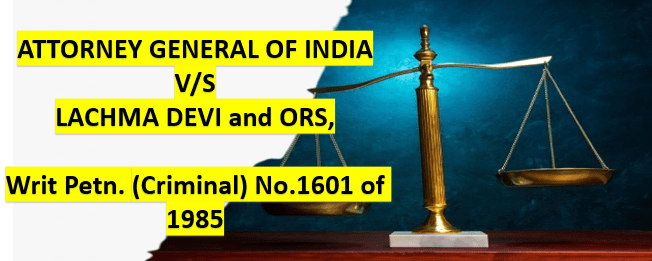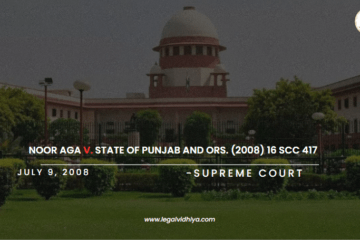
ATTORNEY GENERAL OF INDIA V/S LACHMA DEVI and ORS, Writ Petn. (Criminal) No.1601 of 1985
| Citation | AIR 1986 SC 467 =1986 Cr. L.J. 364=(1986) 1 SCJ 166. |
| Date of Judgment | 13th December 1985 |
| Court | Supreme Court of India |
| Case Type | Criminal Writ petition No.1601 of 1985 |
| Appellant | Attorney General of India |
| Respondent | Lachma Devi and others |
| Bench | P.N. Bhagwati (C.J.I), D.P. Madon, G.L. Oza, (JJ), Jagannatha Shetty. |
| Referred Sections | Article 21, 32 and Section 413, 414, 354(5) of CrPC. |
FACTS OF THE CASE
Attorney General vs Lachma Devi case is also called as Lichhamadevi vs State of Rajasthan. It is a case related to Public Hanging in India.
Lachma Devi was found guilty of murder and sentenced to death by hanging by the Additional Sessions Judge of Bikaner, Rajasthan. The Rajasthan High Court upheld her conviction and sentence. However, Lachma Devi filed a writ petition under Article 32 of the Indian Constitution, challenging the constitutionality of public hanging.
The Attorney General of India stated that, the public hanging was necessary within the criminal justice system as a deterrent to crime. It was contended that the Indian Constitution did not prohibit capital punishment and that the mode of execution was at the discretion of the legislature. Moreover, it was claimed that public hanging was a long-standing practice in India and aligned with the cultural and social values of the country.
Lachma Devi, the respondent contended that public hanging was a barbaric and inhumane practice that violated her fundamental rights under the Indian Constitution. She maintained that public hanging constituted cruel, degrading, and inhuman punishment, contradicting the constitutional principles of dignity and humanity. Lachma Devi further contended that public hanging amounted to torture, which was prohibited under international law, and India had ratified various international conventions outlawing torture.
ISSUES
- The central legal issue in this case was whether public hanging was constitutional
- whether it violated the right to life and personal liberty guaranteed by the Indian Constitution.
- Additionally, the court examined whether public hanging was an integral part of India’s criminal justice system.
ARGUMENTS
In its deliberation, the Court emphasized the responsibility of the State to exercise its authority to impose the death penalty in a manner that upholds the principles of human dignity. This implies that the punishment should not inflict unnecessary suffering or degrade the individual being punished. By highlighting the importance of treating convicts with respect and preserving their inherent dignity, the Court establishes a crucial limitation on the State’s power.
The Court went even further, explicitly condemning the use of gallows for executions, especially when conducted publicly. It categorizes this practice as barbaric, asserting that it has no place in a civilized society. This strong denouncement reflects the Court’s firm stance against methods of execution that promote public spectacle and aim to humiliate and dehumanize the individual facing the punishment.
As a result, the ratio decidendi, or the legal principle that forms the basis of the court’s decision in this case, is that the right to life guaranteed under Article 21 of the Indian Constitution encompasses not only the right to continue living but also the right to die with dignity. The Court declares that public hanging, due to its degrading and inhuman nature, violates this fundamental right. This pronouncement sets a precedent that public hanging is an unacceptable form of punishment, affirming the significance of preserving human dignity even in the face of the death penalty.
JUDGEMENT
The order dated December 13th, 1985 clearly indicates that the Bench had to revoke the previous order directing the execution of the death sentence by public hanging due to the absence of provisions in the Jail Rules for such a method of execution. The Bench stated that the death sentence should not be carried out by public hanging unless the State Government amends the Rules to allow for it at the time of execution. The Bench’s decision to revoke the earlier order was not based on the belief that public hanging is barbaric. We want to emphasize that executing the death sentence by public hanging would be a barbaric practice and a violation of Article 21 of the Constitution. We are pleased to note that no State in the country has a Jail Manual that permits execution by public hanging, which we find to be a repulsive display reminiscent of past centuries. We are certain that the Bench’s expectation of a rule amendment allowing public hanging will not be fulfilled. We consider the directive for public hanging to be unconstitutional, and if any Jail Manual were to include it, we would declare it to be in violation of Article 21 of the Constitution. While it is true that the crime for which the accused have been found guilty is barbaric and brings shame upon a civilized society, a barbaric crime should not be punished with a barbaric penalty like hanging. We completely and unconditionally remove the direction given by the High Court regarding the execution of the death sentence by public hanging. The Writ Petition is concluded with this order.
CONCLUSION
The Supreme Court concluded that the right to life under Article 21 of the Indian Constitution does not include the right to die, and that hanging as a method of executing the death penalty is constitutionally valid. However, the Court also recognized the significance of upholding human dignity and preventing cruelty as enshrined in Article 21. Consequently, a public hanging could be seen as a violation of these rights.
As a result, the Court established guidelines for the implementation of the death penalty, including the requirement for it to be carried out in private and granting the condemned the opportunity to meet with their family and lawyers prior to execution.
In conclusion, the Attorney General of India v/s Lachma Devi case of 1985 underscored the delicate balance between the right to punishment for a crime and the safeguarding of fundamental human rights. The guidelines laid out by the Court continue to shape the execution of the death penalty in India.
REFERENCES
https://www.lawyerservices.in/Attorney-General-of-India-Versus-Lachma-Devi-and-Others-1985-12-13
This Article is written by Mudragada Iswarya Lakshmi, 6th Semester of ICFAI Law University, Intern at Legal Vidhiya.




0 Comments